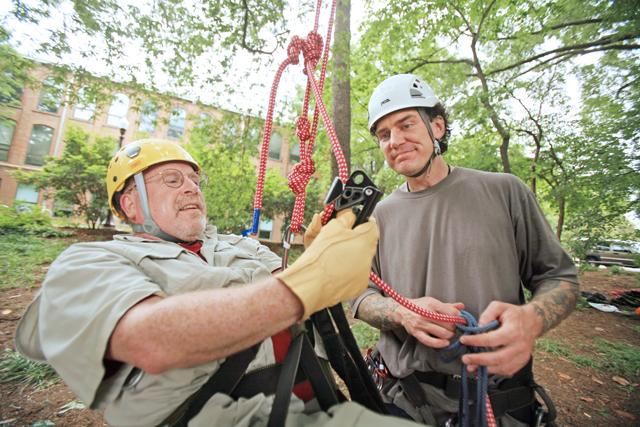
© 2011 NCSU Student Media
Professor in forestry and environmental resources Ted Shear adjusts his climbing rope under the supervision of Tim Kovar, master instructor of Tree Climbers International, outside Caldwell Hall Friday, May 13. Shear was one of the participants in the canopy workshop for biologists and educators that was hosted by Kovar. “I do a lot of work in forestry where I want to get in the canopy,” Shear said. Photo by Jordan Moore
Meg Lowman, a scientist with the North Carolina Museum of Natural Sciences, first started her work in rain forest canopies in 1979 with a will to explore the heights of forest ecology and a harness she fashioned with a sewing machine. Lowman brought her decades of experience to N.C. State to instruct a climbing workshop on what has been her passion and livelihood.
“Because of my canopy research expertise, the biology department at N.C. State invited me to conduct some studies of ants in urban trees in Raleigh and to instruct this workshop,” Lowman said.
Lowman and experts from across the country met May 11 at the Court of North Carolina for the Techniques in Canopy Biology Workshop, sponsored by the University and the museum. Andrea Lucky, a post doctoral researcher in entomology, organized the event to go along with a new project called School of Ants, which is funded by the National Science Foundation.
The three-day workshop coupled climbing lessons with biological lectures to create a more thorough understanding of what canopy research entails.
“The way we structured the workshop was specifically so people who wanted tree climbing experience could enhance their skills and do research,” Lucky said. “This research can include animal behavioral research, forest health research and general questions concerning biodiversity.”
According to Lucky and Lowman, the forest canopy is a habitat that scientists have only recently been exploring, and less than 5 percent of the biodiversity of the canopy is known. Lowman compared it to marine biology.
“It’s very similar to scuba diving,” Lowman said. “Canopy researched was developed only in the 1980s. When I first got involved it was all novel and exciting.”
According to Lucky, rain forests contain the most biodiversity, but temperate climates like Raleigh also contain significant, unexplored canopy life.
“It’s our backyards, but we seldom look at it like the tropics,” Lucky said. “We don’t have a good idea of what is actually living up in the trees in our own backyard, and this extends into plant life, insects and so on.”
Lucky said that the instructors of the workshop focused on how sample local data with the same techniques as in the rain forest.
“These are forests and we look at them with the same curious and objective lens as we would in the tropics,” Lucky said. “In fact, we have a number of new, unnamed ant species that occur here, and we even found a new invasive ant species without any documentation.”
Lowman said that the workshop served as a way to connect the museum and the University, and the workshop registration filled up quickly with faculty and students.
This workshop focused on the basics, and, according to Lowman, the first step is getting into the trees and climbing. However, Lowman is also credited for developing more complex research techniques, including the canopy raft method, which uses a inflatable tubing shaped like a spider web suspended by treetops.
“It’s straightforward to just get in the tree and climb, but we have techniques like canopy walkways, scaffolding, elevated platforms and even construction cranes to help us maneuver in the forest,” Lowman said.
Tim Kovar, a climber from Tree Climbing Northwest based in Oregon, came to instruct scientists from the University and community to scale trees and collect data.
The workshop hosted Stephen Yanoviak from the University of Arkansas in Little Rock to share his experiences with ant research in Central America.
“I first got started with canopy research in Panama, 20 years ago,” Yanoviak said. “I was first studying mosquitoes, and one day I was on the ground when someone yelled down to me to check out some mosquitoes hanging out in a hole in a tree. I said, ‘You have to get me up there,’ and that one comment basically launched my last 20 years of tree climbing.”
Yanoviak specializes with ants and has studied several ant species that can glide if they fall off a branch. According to him, it was a surreal discovery.
“I painted the insects with an orange powder and dropped them off tree branches to study their falling patterns,” Yanoviak said. “They would glide back to the trunk a statistically significant number of times, so it wasn’t happening by chance. And let me clarify, I don’t torture ants for fun—it’s for science.”
Yanoviak will soon travel to Panama to continue research on these gliding species of ants. He said that research in the canopy gives an entirely new perspective of the forest, but it takes a toll.
“It’s tiring to go up in the trees,” Yanoviak said. “Sometimes I don’t feel like climbing, but it’s been an exciting part of my life.”
Lowman said she looks forward to climbing and helped instruct the final day of the workshop at Sunday Kids’ Climb at Blue Jay Point County Park.
“It’s great working with the kids, and we have to remember that passing on this experience is important for science.”